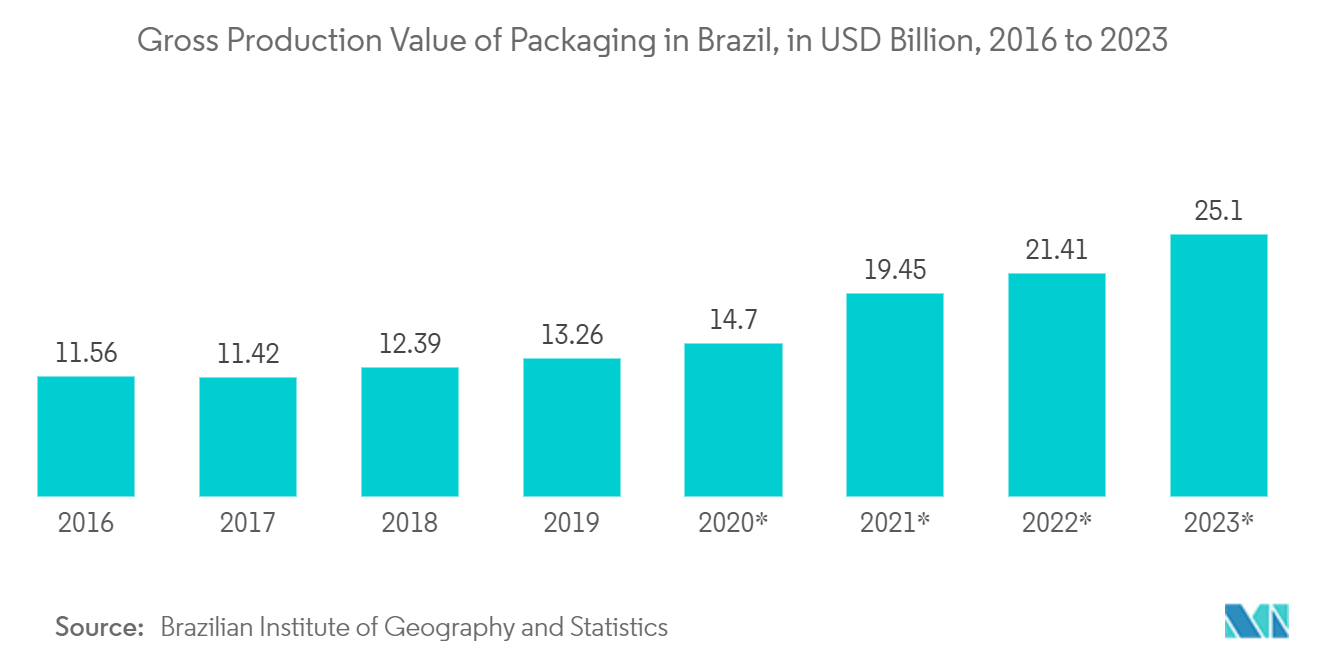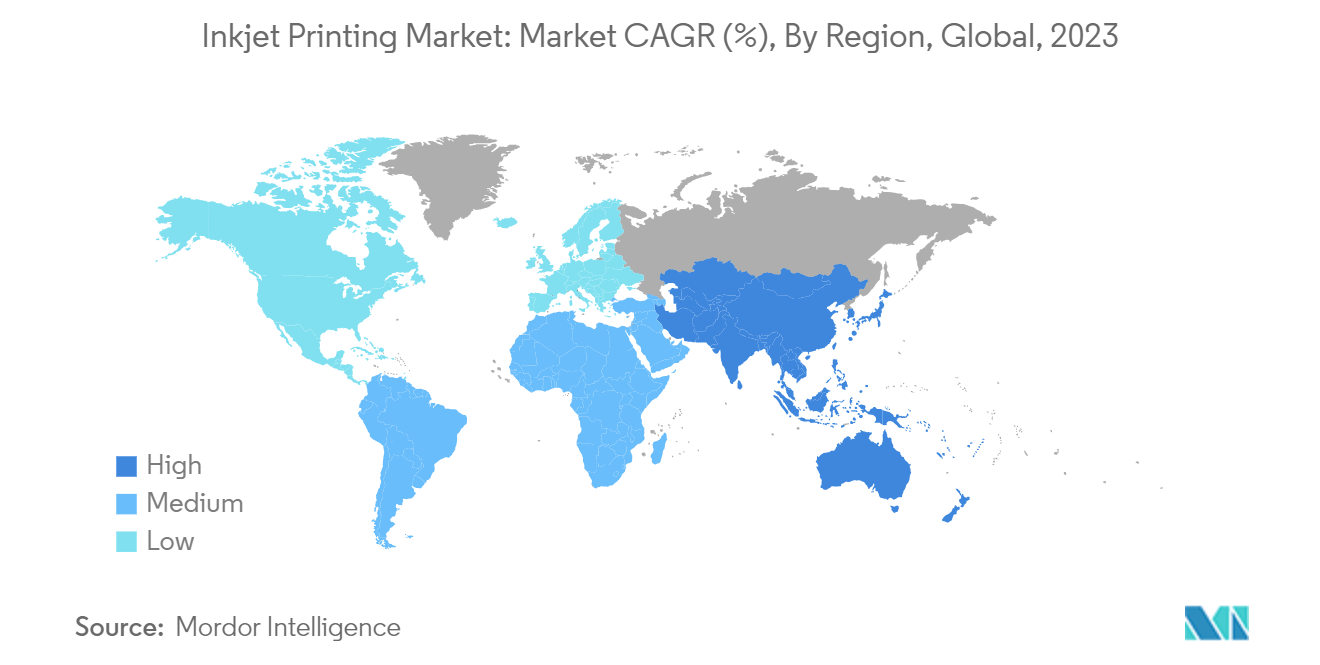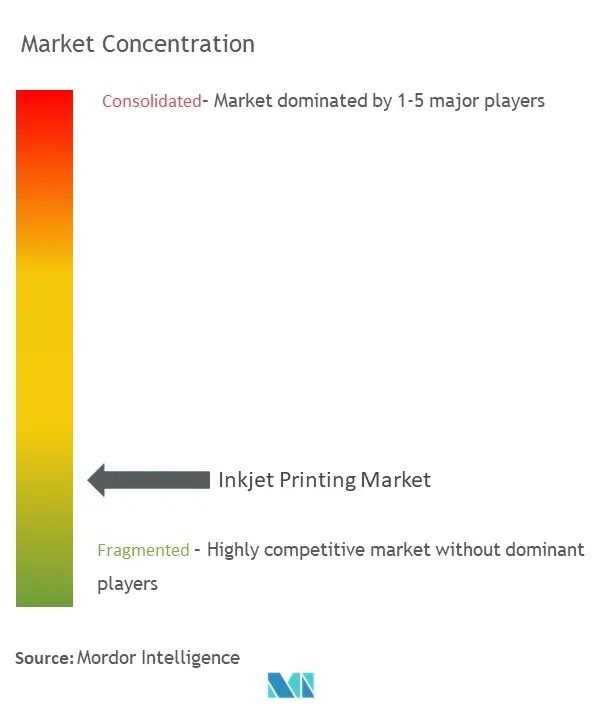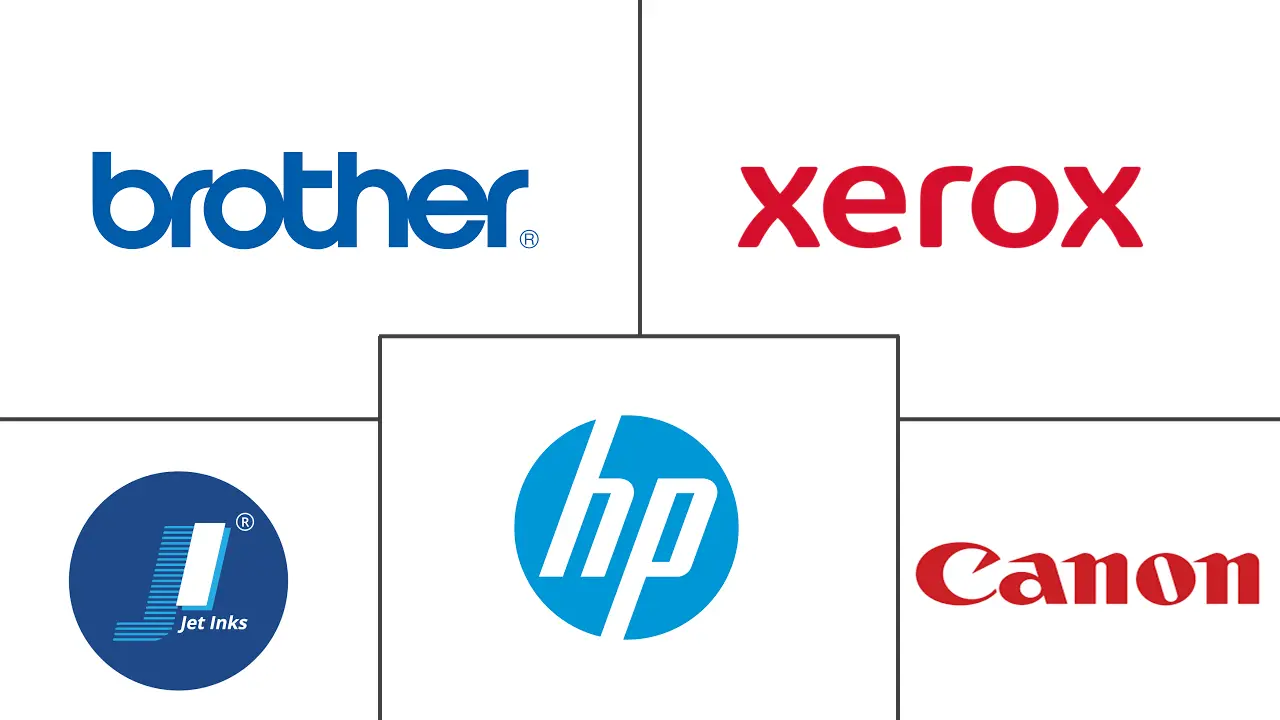
Inkjet Printing Market Analysis
The Inkjet Printing Market size is worth USD 116.60 Billion in 2025, growing at an 7.24% CAGR and is forecast to hit USD 165.38 Billion by 2030.
- Inkjet printing, a method that disperses tiny droplets of liquid ink onto various surfaces such as paper, has been instrumental in the advancement of digital printing. This technique produces high-resolution images that rival traditional photographs. One of the most remarkable features of inkjet printing is its affordability. It provides exceptional flexibility and requires minimal initial investment, making it particularly suitable for economical, low-volume, and single-copy printing tasks. Inkjet printers are especially advantageous for the efficient production of short runs and customized products.
- The demand for ink in the inkjet printing industry is transforming its ecosystem. At present, solvent, water-based, and UV inks dominate the market, with LED inks also gaining ground. Despite being a well-established technology, inkjet printing is experiencing growing usage due to advancements in technology that are reshaping the role of print in communication, driven by personalization, integration, interactivity, mobility, and the need for diversification. Commercial printing has been a widely used method since the introduction of the printing press.
- The increasing need for UV-curable inks is a major factor influencing the inkjet printers market, especially in sectors like packaging. UV-curable inks also offer the benefit of being able to stick to a variety of surfaces. They can securely attach to different materials, such as plastics, glass, metal, and even unique surfaces like wood and ceramics. This flexibility enables printing on a wide range of substrates, broadening the potential applications of inkjet printers. These notable developments are projected to boost market growth.
- The integration of inkjet printing with digital innovations, including cloud computing, artificial intelligence, and the Internet of Things, is transforming the printing industry. Print heads equipped with IoT technology are improving operational efficiency by minimizing downtime through capabilities such as remote monitoring, diagnostics, and predictive maintenance. Additionally, software solutions driven by AI are boosting both efficiency and print quality by effectively managing color, processing images, and optimizing workflows.
- The growth of the inkjet printing market is being fueled by the increasing use of large-format printers, investments from various vendors, and the availability of a wide range of inks. In February 2024, HP introduced its HP Thermal Inkjet (TIJ) 108 mm Bulk Printing Solution, which aims to transform packaging processes in the industry with its efficient, adaptable, and environment-friendly printing technology. This new addition to the TIJ 4.0 Printhead technology offers high speeds, excellent resolution, and throw distances of up to 10 mm, making it suitable for a variety of wide-swath, high-volume printing tasks without the need for stitching.
- In commercial print applications, inkjet technology is becoming more prevalent. Wide-format and high-speed presses are now accompanied by high-quality sheet-fed inkjet presses. For example, in response to the shift toward electronic media and online shopping, book printing is increasingly utilizing inkjet printing. The single-pass web inkjet press plays a key role in this transformation, connecting mono and color presses to efficient cutting and folding systems to produce sections or blocks for near-line binding.
- In the field of printing technologies, inkjet printing is encountering strong competition from well-established methods like flexographic and screen printing. The slow expansion of flexographic printing indicates its strong presence in important industries, which in turn restricts the potential for inkjet technologies to gain a substantial market share. Inkjet printing, which is frequently linked to higher initial expenses and ongoing operational costs like ink cartridges, may find it challenging to compete in terms of cost per page, especially in environments with high-volume production.
Inkjet Printing Market Trends
Packaging Segment is Expected to Witness Major Growth
- Inkjet printing is playing a major role in the packaging industry because of its flexibility and ability to customize on demand. This printing technique is particularly effective in variable data printing, making it possible to create personalized packaging, targeted marketing campaigns, and seasonal designs with minimal setup time. Furthermore, inkjet printing enables efficient short-run production, which helps to reduce inventory costs and allows businesses to print packaging as required. Given its suitability for meeting dynamic market demands and introducing new products, the adoption of inkjet printing in packaging is on the rise.
- Despite the widespread use of plastic in packaging, printing on this material poses certain difficulties. This is especially important for businesses that need to print traceable codes and essential product information (like expiration dates) to meet regulatory and distributor requirements. Selecting the right printer and ink is essential for successful plastic marking, as with any material. In the realm of industrial plastic coding, inkjet printing has become more popular due to its speed, reliability, and compatibility with various types of ink.
- The food packaging industry is progressively adopting continuous inkjet (CIJ) printers. These printers are preferred due to their high-speed performance, which is well-suited for the extensive operations typical in food packaging. In light of the rigorous safety regulations, it is essential for these printers to demonstrate resilience against environmental conditions, including fluctuations in temperature and humidity. As durability plays a vital role in ensuring operational efficiency, adherence to regulations, and the overall quality of packaged food, CIJ printers have emerged as the preferred option for food packaging applications.
- The packaging industry is gradually transitioning toward inkjet printing despite facing challenges related to cost and speed. Technological advancements, a focus on sustainability, and the advantages of inkjet are anticipated to propel its adoption in the future. The expanding capabilities of the packaging industry in countries like Brazil, India, the United States, and China are expected to have a substantial impact on the market. According to BIGS, Brazil's packaging industry had a gross production value of BRL 144.4 billion (USD 23.75 billion) in 2023, marking a significant increase from the previous year and a notable growth compared to 2016.
- In October 2023, Nordmeccanica, a renowned global manufacturer specializing in coating, laminating, and metalizing technology, formed a strategic partnership with Fujifilm for inkjet printing. This joint effort is designed to bring production benefits to customers of Fujifilm's upcoming Jet Press FP790 digital inkjet flexible packaging solution. The agreement with Nordmeccanica added to the list of successful partnerships with Hybrid Software and Henkel Adhesive Technologies. These significant collaborations in advancing innovations in packaging applications are expected to drive market growth.

Asia-Pacific is Expected to Register the Fastest Growth
- The surge in consumer spending in Asia-Pacific, spearheaded by China, India, and various Southeast Asian countries, is fueling an increase in the demand for printed goods. This rise in demand is particularly evident in the need for packaging and labels, textbooks, and other printed materials, underscoring the expanding significance of inkjet printing in the region. The printing industry is undergoing a transformation due to technological advancements, particularly in digital printing.
- The rise in demand can be attributed to the ample opportunities stemming from the low labor and manufacturing costs in Asia-Pacific, positioning it as a key location for establishing production plants for mass-producing inkjet printers. Furthermore, the increasing popularity of inkjet digital printers in China has resulted in a significant shift. The consumables required for these printers now represent a notable expense for manufacturers in the printing and processing sector. As the usage of these printers continues to grow, the replacement of original consumables becomes a major cost.
- In June 2024, KINGTAU, a leading Chinese producer of industrial inkjet printers, introduced its most recent products. The T320, recognized for its high-resolution printing and UV ink capabilities, delivers exceptional quality. Meanwhile, the SCB1600 single-pass, high-speed corrugated digital printer is revolutionizing efficiency in corrugated packaging. By employing a pass-through printing method and a KCMY four-color setup, the SCB1600 maximizes color blocks, guaranteeing vivid full-color prints. These noteworthy advancements by the vendor in the area are also anticipated to bolster market growth.
- Similarly, the market is also expected to witness significant growth in Japan. According to the Japan Printing Machinery Association (JPMA), the quantity of industrial digital printing machines (A3 format and larger) increased from 11,272 units in 2014 to 16,010 units in 2023. Although Japan is currently behind in 3D printer usage compared to other countries, there is a significant increase in businesses owning multiple units. Additionally, as these companies acknowledge the advantages, there is a growing desire to upgrade to more advanced models.
- Vendors in the region are significantly investing in introducing various products. In June 2024, Tokyo-based Zeon Corporation strategically invested in Inkbit Corporation, a company specializing in high-precision, multi-material 3D inkjet printing systems. Inkbit's leading product, Vision-Controlled Jetting (VCJ), is designed to seamlessly shift from prototyping to mass production, specifically for creating 3D parts using polymers with varying characteristics.
- Moreover, the printing industry in Australia has been transformed by technological advancements. A growing number of customers are choosing cost-effective and faster options by obtaining prints from abroad. The quality of these imported prints has seen enhancements. In order to remain competitive, Australian printers are refining their operations to achieve higher levels of efficiency. As consumer preferences across the region pivot from plastic to paper in packaging, a burgeoning market opportunity has emerged, with vendors eager to lead the charge. Such factors are expected to drive the market's potential in regions like Australia.
- The market is also expected to witness a notable demand in India due to the increasing adoption of digital printing technologies and growing investments in the packaging sector. India is poised for substantial growth in the e-commerce industry, driven by the increasing number of internet users and favorable market conditions. With the growing vendor investments in driving the packaging capabilities across industries like food and pharmaceuticals, the need for digital printing technology is expected to rise. This trend is creating a demand for advanced packaging solutions that can accommodate personalized products, thereby contributing to the market's growth.

Inkjet Printing Industry Overview
The inkjet printing market is highly fragmented due to the presence of a large number of players. Market penetration is growing, with a strong presence of major players in established markets. Considering the homogenous nature of market products, many firms operating are further driven to compete on price, and some of the key players include HP Development Company LP (HP Inc.), Jet Inks Private Limited, Brother Industries Ltd, Xerox Corporation, and Canon Inc.
- May 2024: Canon and Heidelberger Druckmaschinen AG (HEIDELBERG), leaders in inkjet and sheet-fed offset printing technology, revealed their worldwide sales and service collaboration in inkjet printing. The company’s combined efforts are aimed at assisting commercial print businesses in transitioning to hybrid offset/digital production in order to adapt to evolving print buyer demands and enhance their capacity to manage shorter print runs and a wider variety of jobs.
- November 2023: Brother Industries launched its newest inkjet printer, the MFC-J1800DW Print & Cut All-in-One Color Inkjet Printer. This model signifies the brand's initial venture into automatic paper cutting. The Print & Cut system makes use of the state-of-the-art Brother Blade Sensor Technology (BST) to ensure precise cutting of full letter pages. Marketed as a versatile solution, the Print & Cut is aimed at consumers in search of a compact, all-in-one printer for their daily printing tasks.
Inkjet Printing Market Leaders
-
HP Development Company LP (HP Inc.)
-
Jet Inks Private Limited
-
Brother Industries Ltd
-
Xerox Corporation
-
Canon Inc.
- *Disclaimer: Major Players sorted in no particular order

Inkjet Printing Market News
- June 2024: CMYKhub, Australia's foremost wholesale printing company, expanded its operations into inkjet production by acquiring two Canon varioPRINT iX3200 cut-sheet presses at the Drupa Trade Fair. This family-owned enterprise caters to a diverse range of clients, including independent printers, franchise organizations, print brokers, advertising agencies, and graphic designers. CMYKhub offers a wide array of printed products, encompassing business cards, brochures, stationery, calendars, banners, signage and displays, labels, and packaging solutions.
- June 2024: Tohoku Epson Corporation, a subsidiary of Seiko Epson Corporation, allocated around JPY 5.1 billion (USD 32.58 million) toward a brand-new inkjet printhead manufacturing plant. The initiation of construction was commemorated with a groundbreaking ceremony held at the Tohoku Epson facility. Commencing in 2024, the project is set to be completed by September 2025. This strategic maneuver is anticipated to quadruple Tohoku Epson's printhead production capacity.
Inkjet Printing Industry Segmentation
Inkjet printing is the most widely used form of digital printing for small, inexpensive consumer models and expensive professional machines. The market is defined by the revenue accrued from selling inkjet printing solutions worldwide. The inkjet printing market is segmented by application and geography. By application, the market is divided into books/publications, commercial printing, advertising, transactions, labels, packaging, and other applications. By geography, the market is segmented into North America, Europe, Asia-Pacific, Latin America, and Middle East and Africa. The market sizes and forecasts are provided in terms of value (USD) for all the above segments.
| By Application | Books/Publishing |
| Commercial Print | |
| Advertising | |
| Transaction | |
| Labels | |
| Packaging | |
| Other Applications | |
| By Geography*** | North America |
| Europe | |
| Asia | |
| Australia and New Zealand | |
| Latin America | |
| Middle East and Africa |
Inkjet Printing Market Research Faqs
How big is the Inkjet Printing Market?
The Inkjet Printing Market size is worth USD 116.60 billion in 2025, growing at an 7.24% CAGR and is forecast to hit USD 165.38 billion by 2030.
What is the current Inkjet Printing Market size?
In 2025, the Inkjet Printing Market size is expected to reach USD 116.60 billion.
Who are the key players in Inkjet Printing Market?
HP Development Company LP (HP Inc.), Jet Inks Private Limited, Brother Industries Ltd, Xerox Corporation and Canon Inc. are the major companies operating in the Inkjet Printing Market.
Which is the fastest growing region in Inkjet Printing Market?
Asia Pacific is estimated to grow at the highest CAGR over the forecast period (2025-2030).
Which region has the biggest share in Inkjet Printing Market?
In 2025, the North America accounts for the largest market share in Inkjet Printing Market.
What years does this Inkjet Printing Market cover, and what was the market size in 2024?
In 2024, the Inkjet Printing Market size was estimated at USD 108.16 billion. The report covers the Inkjet Printing Market historical market size for years: 2019, 2020, 2021, 2022, 2023 and 2024. The report also forecasts the Inkjet Printing Market size for years: 2025, 2026, 2027, 2028, 2029 and 2030.
Our Best Selling Reports
Inkjet Printing Industry Report
The Global Inkjet Printers Market is on the rise, fueled by advancements in inkjet printing technology and a growing demand in various sectors. UV-curable inks are gaining popularity for their quick-drying, durable qualities, especially in signage, graphics, and packaging. The surge in eCommerce is pushing the need for inkjet printers in packaging and labeling, while the shift towards digital printing offers faster turnaround times and cost-effective solutions for small to medium runs. Large format and continuous inkjet technologies are in high demand for outdoor advertising and industrial applications. The institutional sector also relies on inkjet printers for versatile, high-quality printing. Technological advancements are enhancing printer speed, quality, and substrate compatibility, broadening their applications to 3D and direct-to-garment printing. According to Mordor Intelligence™ Industry Reports, the inkjet printing market is witnessing significant growth, with detailed analysis and forecasts available in their free report PDF download, highlighting the market's size, share, and revenue growth.



